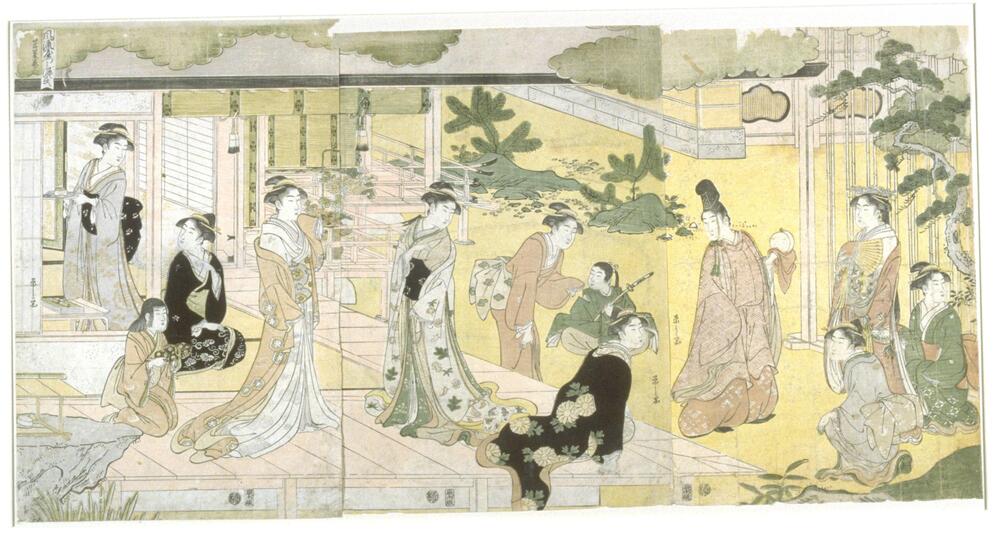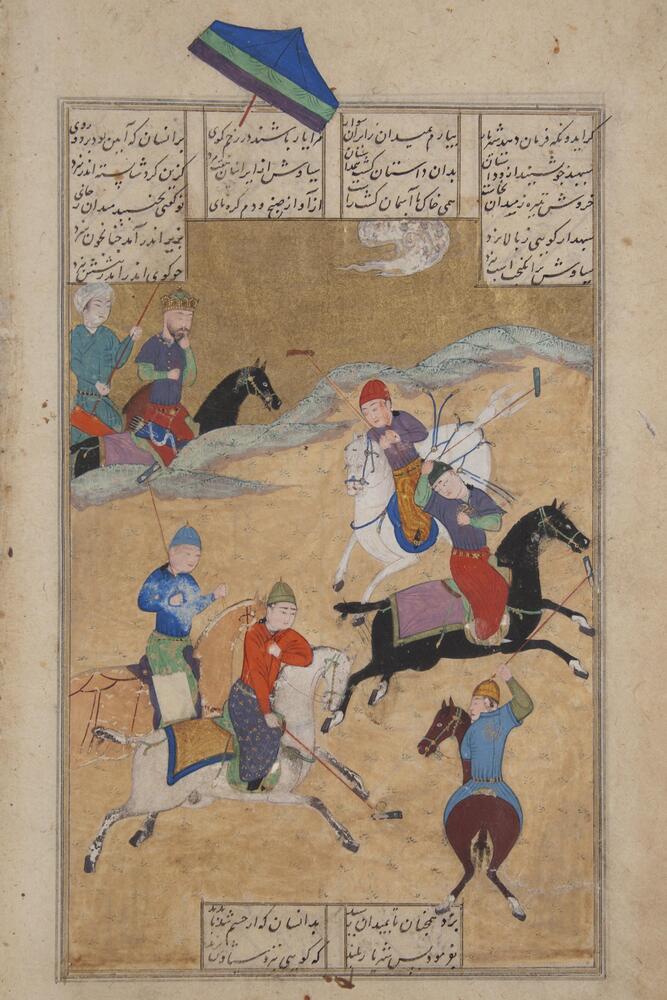Lesson Plan: Asian Epics
“Stories from the Past: Narrative in Asian Art” UMMA Workshop for Educators, 2004
Objectives
Students will compare and contrast three classics of Asian literature: The Tale of Genji (a classical Japanese romance “novel”), the Shahnama (national epic of Persia), and the Ramayana (a Hindu tale of the conflict between good and evil). They will analyze three images and question how artists translate literature into visual form.
National Core Standards
Relate artistic ideas and works with societal, cultural, and historical context to deepen understanding
Perceive and analyze artistic work
Produce clear and coherent writing in which the development, organization, and style are appropriate to task, purpose, and audience.
Grades
9-12
Time Required
One or two class periods
Materials
Images of Tale of Genji, the Shahnama, and the Ramayana
Excerpts from the epic poems
Lesson
- Provide background on three classic works of Asian literature: The Tale of Genji, the Shahnama, and the Ramayana.
The Tale of Genji: Written over 1,000 years ago by an aristocratic woman known as Murasaki Shikibu, this 54-chapter romance is considered to be one of the first “novels,” and explores the psychological development of the characters. The primary characters are aristocrats concerned with social status, beauty, fashion, and calligraphic art. They rarely traveled and did not engage with people of lower classes. Hence, a novel that contained romance, travel, and adventure was extremely popular – as a window into unknown worlds. Genji is a handsome and gifted prince who seems selfish in the beginning of the novel but becomes more heroic and protective of women as the novel progresses. For more information, see: http://www.taleofgenji.org/
The Shahnama: the Iranian “Book of Kings,” is an epic poem that tells of the royal reigns of kings from ancient past until the mid-seventh century. The following description is courtesy of Maribeth Graybill, former Senior Curator of Asian Art at UMMA: “Composed by the poet Firdausi (932-1025 CE), this monumental poem opens with the creation of the world and the reigns of the first shah and his successors, who gave humankind fire, agriculture, and other tools. An ‘Age of Heroes’ then ensues, where we learn of the deeds of legendary kings as well as the champions who served them. With the appearance of ‘Sikander’ (Alexander the Great), the Shahnama passes into an ‘Age of History,’ which focuses on the kings and noble families of the Sassanian Dynasty (24-642). The tale draws to a close with the fall of the Sassanian capital in 642 to invading Arabian armies, proselytizers of Islam. Beneath the engaging stories of ardent romance, bloody combats, and triumphs and tragedies, lies a constant concern with a divinely sanctioned order in which kings shoulder the responsibility of maintaining peace by ruling with wisdom and justice. The Shahnama reminds us that while the institution of kingship may be divine, kings themselves are only human. Fate and fallibility often cause kings to fall far short of the royal ideal, creating discord between them and their champions and heirs that threatens the fabric of human society.”
The Ramayana: this Sanskrit epic poem contains Hindu teachings and has influenced art and literature since 100BCE. It is often reenacted in theater productions. The following is excerpted from the British Library Online Gallery: “Rama won the hand of the beautiful princess Sita, but was exiled with her and his brother Laksmana for 14 years through the plotting of his stepmother. In the forest Sita was abducted by Ravana, and Rama gathered an army of monkeys and bears to search for her. The allies attacked Lanka, killed Ravana, and rescued Sita. In order to prove her chastity, Sita entered fire, but was vindicated by the gods and restored to her husband. After the couple’s triumphant return to Ayodhya, Rama’s righteous rule inaugurated a golden age.” http://www.bl.uk/onlinegallery/whatson/exhibitions/ramayana/guide.html
- Read translated excerpts from the three epic poems, if accessible and fitting your students’ ability. Discuss similarities between the epics (aristocratic characters, travel, tales of adventure, conflicts between characters, a monumental sense of history, reflection of cultural values) and differences (settings, time frames, priorities, literary styles, perspective on the divine, abilities or supernatural abilities). It may be helpful to set up this compare/contrast in a chart form.
- View images of each epic, analyzing the visual strategies of the artist. How did s/he depict the narrative? Are the figures flat or dimensional? How do landscape and background relate to the figures? Which colors are used? Is text integrated into the image? How do the artist’s choices reflect a distinct cultural sensibility?
Part of 1 Learning Collection
“Tradition Transformed: Chang Ku-nien Master Painte...
“Creative Literacies: Expanding our View,” UMMA Wor...
UMMA Exhibition, “The Graphic Dimension: Prints and...
“Creative Literacies: Expanding our View,” UMMA Wor...
“Teaching with Photography,” UMMA Workshop for Educ...
“Creative Literacies: Expanding our View,” UMMA Wor...
Lesson adapted from Educator Resources, Victoria & ...
“Benjamin West: General Wolfe and the Art of Empire...
“Creative Literacies: Expanding our View,” UMMA Wor...
“Teaching with Photography” UMMA Teacher Workshop,...
Lesson inspired by Elaine Wilson’s “Charting the Wo...
“Tradition Transformed: Chang Ku-nien Master Painte...
UMMA Teacher Workshop, “Xu Weixin: Monumental Portr...
“Teaching with Photography,” UMMA Workshop for Educ...
“Teaching with Landscape Photography,” UMMA Teacher...
UMMA Teacher Workshop, “Xu Weixin: Monumental Portr...
“Creative Literacies: Expanding our View,” UMMA Wor...
Rate this Resource
AVG: 0 | Ratings: 0
& Author Notes
Creative Commons by-nc-saLast Updated
May 31, 2017 8:50 a.m.Report
Reporting Policy



